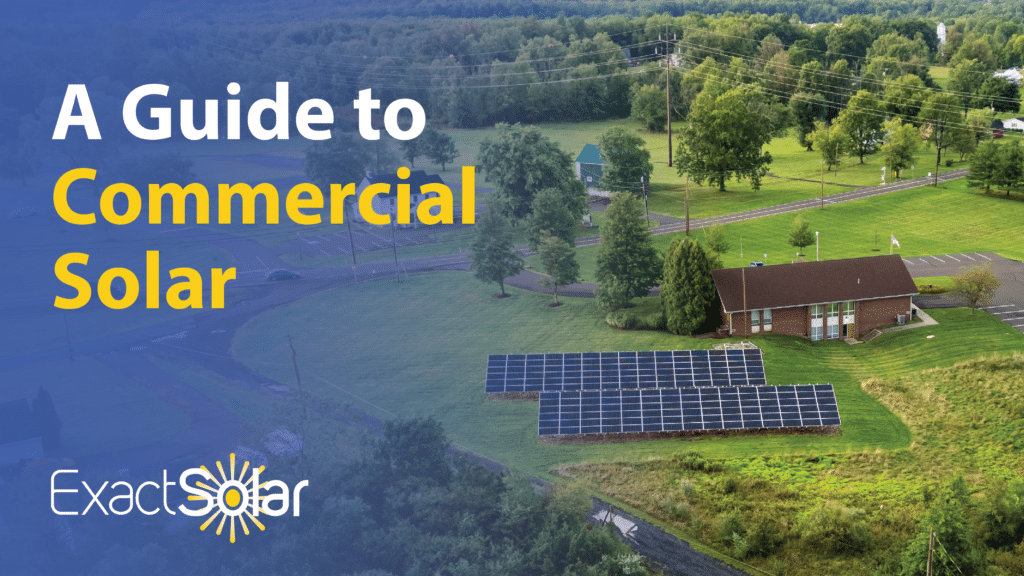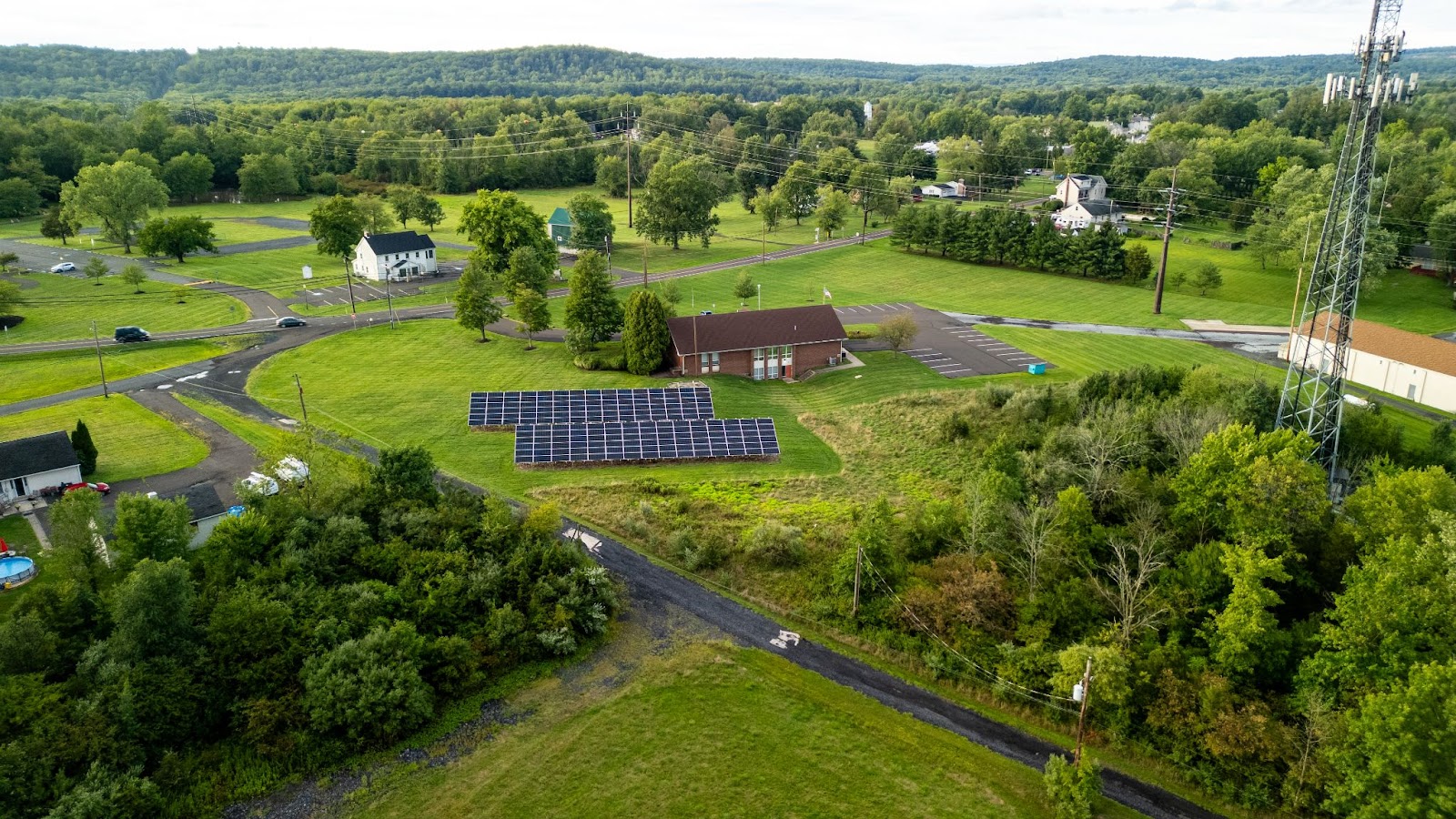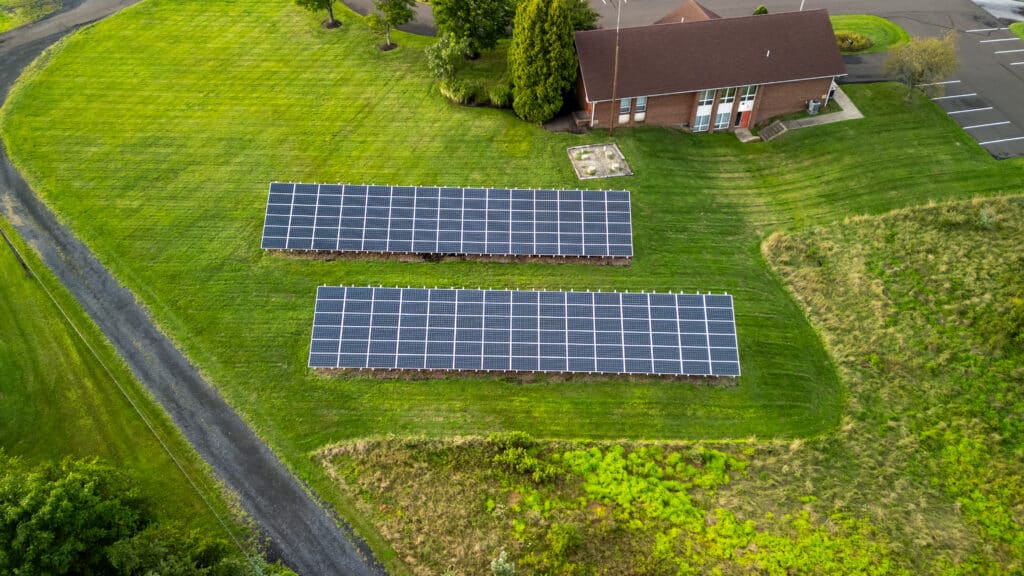
American businesses spend more than $200 billion on energy each year. Until recently, this was simply the cost of doing business. Today, solar energy offers a compelling alternative. It’s becoming the preferred choice for businesses and organizations looking to reduce costs, meet sustainability goals, and stay ahead in a world focused on environmental responsibility.
Solar energy is transforming how businesses operate by providing predictable energy costs, significant savings, and a strong return on investment. Beyond financial benefits, going solar strengthens your reputation as a leader in sustainability, contributing to a cleaner, greener future for everyone.
With installation costs at a historic low and federal incentives at their highest, there’s never been a better time to explore your solar options. At Exact Solar, we specialize in helping businesses of all sizes switch to solar energy.
In this guide, we’re providing you with everything you need to know about solar for your business or organization, outlining the entire process step-by-step.
If you have questions that this guide has not answered, or you are curious to learn more about how solar could benefit your business, reach out to our team for a free consultation!
Table of Contents
Understanding Commercial Solar
What Is Commercial Solar?
“Commercial solar” refers to solar energy systems installed on commercial properties.

These systems consist of electricity-generating photovoltaic (PV) panels and their associated components mounted on commercial buildings, such as offices, warehouses, and factories. The term “commercial solar” even includes schools and government facilities. It simply refers to solar systems that are not on residential properties or are not utility-scale.
Commercial and residential solar installations are considered “behind the meter,” meaning that they’re owned and managed by the property owner, who sells the electricity they generate back to the grid. If a system is “in front of the meter,” it’s owned and managed by the utility company.
Commercial solar installations can benefit businesses of all sizes, from small local businesses to large industrial complexes and warehouses.
By adopting solar energy, owners of these buildings can reduce their reliance on more traditional and expensive energy sources, freeing up additional budget they can invest back into their businesses.
How Do Commercial Solar Systems Make Money?
At the core of any solar system are photovoltaic cells that convert sunlight into electricity, which becomes a valuable asset for the business owner. Here’s how the process works:
- Investing in a Solar System
A commercial property owner looking to reduce their energy bills hires a solar installation company to install a solar energy system. After completing the permitting and installation process, they receive permission to operate (PTO) from the utility company and turn on their system. - Claiming Tax Credits
In the tax year following permission to operate, the system owner can claim the 30% Investment Tax Credit (ITC) on their total installation cost, along with any other incentives their project qualifies for. - Solar Panels Capture Sunlight
Once operational, PV panels installed on the roof or ground absorb sunlight and convert it into clean direct current (DC) electricity. - Inverters Convert DC to AC
The DC electricity flows to inverters, which convert it into alternating current (AC) electricity to power the building. - Electricity Powers the Building
The AC electricity is distributed through the building’s electrical system, running lights, equipment, and appliances. - Lower Electricity Costs
Depending on the system size, the building owner sees significantly lower electric bills, or none at all, since their system covers most of their energy needs. - Earning Credits Through Net Metering
When the solar system produces excess electricity, the surplus is sent back to the utility grid, a process known as “net metering.” Through net metering programs, businesses receive credits for this energy, reducing future energy bills and generating income. - Generating Revenue with SRECs
In Pennsylvania, New Jersey, and Delaware, Solar Renewable Energy Credits (SRECs) are issued for every 1,000 kWh generated. The building owner or third-party brokerages acting on the building owner’s behalf sell these credits to the utility, creating an additional revenue stream. - Depreciating the Solar System with MACRS
Through the Modified Accelerated Cost Recovery System (MACRS), business owners can depreciate a percentage of their solar installation costs each year, reducing taxable income. Percentages vary, so consulting a tax professional is strongly advised.
Types of Commercial Solar Installations
Solar systems are highly customized, and designed specifically for the property they serve. Commercial solar installations come in various forms, each tailored to different business needs and property types. For example, a ground-mounted system might be ideal for a rural business with ample land, while a rooftop system or a solar carport suits urban businesses with limited space.
Below, we’ve outlined the main types of commercial solar systems.
Rooftop Solar Energy Systems
Rooftop solar is ideal for businesses with adequate roof space, like manufacturing plants, warehouses, etc. Rooftop systems can be installed on various roof types, including flat and slanted roofs and those with different materials like metal, rubber, or tile.

Ground-Mounted Solar Energy Systems
For businesses with available land but limited roof space, ground-mounted solar systems provide an efficient way to generate clean electricity. They offer easier access for maintenance and can be strategically positioned for optimal sun exposure.

Solar Carports
These dual-purpose structures generate electricity while providing shaded parking. They are especially beneficial for businesses with large parking lots and can be integrated with EV chargers for added convenience.
Financial Benefits and Costs of Commercial Solar
Disclaimer: The following section is for illustrative purposes only and is intended to highlight the benefits of investing in commercial solar. It should not be considered legal or tax advice. Please consult a qualified tax professional for guidance on calculating depreciation for your business assets.
How Much Does Commercial Solar Cost?
The cost of commercial solar systems can vary based on factors such as electricity usage, location, and the components selected. In general, larger systems tend to reduce the price per watt (PPW) due to economies of scale, but the return on investment (ROI) can take time. Here are some of the most common pricing factors:
- System Size: Larger systems often benefit from economies of scale, lowering the price per watt (PPW).
- Installation Type: Ground-mounted and carport systems may cost more than rooftop systems due to additional materials and labor for infrastructure.
- Equipment Quality: High-efficiency panels and advanced inverters may increase upfront costs but offer better long-term performance.
- Location and Interconnection Fees: Utility interconnection costs and local permitting fees can vary.
Fortunately, solar power is vastly cheaper than it was just a decade ago. The Solar Energy Industries Association (SEIA) reports that the average cost of commercial solar installations has decreased by over 70% due to cheaper materials and increased market competition.
How Does the Federal Investment Tax Credit (ITC) Work for Commercial Solar?
One of the most significant incentives for businesses to invest in solar is the Federal Investment Tax Credit (ITC), which allows businesses to deduct 30% of the cost of a solar system from their federal taxes. For 501(c)(3) or religious organizations, this amount can be received as a cash payment.
We’ve written an in-depth guide to the tax benefits of the Inflation Reduction Act for businesses, which you can find here. Here’s a quick summary of the ITC benefits:
The ITC currently provides a 30% tax credit for commercial solar systems under 1 megawatt (MW). For systems over 1 MW, the project must meet prevailing wage and apprenticeship requirements to qualify for the full ITC.
Bonus ITC Incentives
There are three additional 10% bonus credits available under the ITC, which are not mutually exclusive. A business can increase the ITC by up to an additional 30%, resulting in a total tax credit of 60%, if:
- The system uses domestic content (steel, iron, and materials manufactured in the USA).
- The installation is in an energy community or Brownfield site (areas with significant fossil fuel employment, high unemployment rates, or contamination from radiation or toxic waste).
- The system is installed in a low-income area or on tribal land.
According to the IRS and the U.S. Department of Energy, a $100,000 solar system could qualify for a $30,000 tax credit, reducing the net cost to $70,000. If all three bonus incentives apply, the tax credit could increase to 60%, reducing the net cost to $40,000.
Additional Incentives
In addition to the incentives mentioned previously, there are also several state-level and local incentives available to solar system investors.
SRECs
Solar Renewable Energy Certificates (SRECs) are tradable credits that represent the environmental benefits of solar energy generation. For every megawatt-hour (MWh) of electricity a solar system produces, one SREC is “minted.”
Utility companies purchase SRECs from solar system owners to meet state renewable energy targets. In states with SREC markets, system owners can benefit from both energy savings and the financial returns from selling SRECs to utilities.
SREC prices fluctuate based on supply and demand, and each state’s market operates differently. As a result, the value of SRECs can vary significantly depending on where the system is installed.
Net Metering
Net metering allows owners of solar energy systems to earn credits for the excess electricity their systems generate. When a solar system produces more electricity than needed, it automatically sends the surplus back to the grid, and the system owner receives credits on their utility bill.
During times when the system produces less electricity than consumed, such as at night or on cloudy days, the owner can use these accumulated credits to offset their electricity usage, lowering their overall energy costs.
Net metering helps make solar more financially viable by reducing reliance on expensive energy storage solutions. However, net metering policies differ between states and utility providers.
Some states are moving toward “time-of-use” or “value-of-solar” tariffs, which offer different compensation rates based on when energy is generated. Despite this, net metering remains one of the most popular incentives for solar adoption.
USDA REAP Grants
The USDA’s Rural Energy for America Program (REAP) offers grants covering up to 25% of project costs for eligible rural businesses and agricultural producers. This can significantly reduce the net investment for those in rural areas who invest in commercial-scale solar.
These grants are currently pending review by the USDA following President Trump’s “Energy Emergency” executive order.
Solar Financing Options for Businesses
It is a common misconception that you need to pay upfront for a solar system. In fact, there are a variety of ways that business owners can affordably finance solar projects.
We’ve written a comprehensive guide to solar financing featuring our preferred solar financing partner, Clean Energy Credit Union (CECU). If you’re interested in learning more, you can read it here. Otherwise, we’ve prepared a brief overview of the options available to businesses below.
Overview of Financing Options
Businesses have several financing avenues to consider:
Cash Purchase
In a cash purchase, the business purchasing the solar system simply pays cash upfront to cover the entire system cost.
- Pros: Maximizes savings over the system’s lifetime and offers the fastest return on investment (ROI).
- Cons: Requires a significant upfront capital investment.
Solar Financing
In a financing agreement, the installer and business work together to find financing partners to cover the cost of the installation. The business will repay this over time.
- Pros: Lower upfront cost, immediate energy savings, and eventual system ownership.
- Cons: Interest costs and potential credit impact when applying for a loan.
Power Purchase Agreements (PPAs)
A PPA is an agreement between a solar installation company and a property owner. The installation company installs a system on the owner’s property, but the installer retains ownership of the system. In this model, the property owner is essentially “renting” the solar system and purchasing the power that the system generates.
- Pros: No upfront costs, predictable energy pricing (unlike rising electricity rates), and maintenance covered by the installer.
- Cons: The business does not own the system and, therefore, cannot claim related tax incentives.
Solar Leasing
Solar leases are very similar to a PPA. Instead of buying the power, the business rents the system itself for a fixed monthly payment.
- Pros: Lower upfront costs with a predictable monthly expense.
- Cons: Less control over the system and fewer tax benefits.
If you’d like to know more about any of the above, the EPA has released an in-depth guide that walks commercial property owners through clean energy financing options step-by-step.
Choosing a Reliable Solar Installer
Even if your business isn’t within Exact Solar’s service area, we want you to have the best possible experience going solar. Committing to 25 to 30 years of onsite power generation is a big decision, and your business deserves an installer who will treat your property as if it were their own.
Here’s a checklist to help you partner with the right solar installer:
Certifications
Look for NABCEP-certified companies with in-house electrical licenses. Ensure they are certified through manufacturers like Enphase, SolarEdge, and others to install the specific components in your system.
Experience
Review their portfolio of commercial installations. Ask about the largest and most complex projects they’ve handled and how they navigated challenges during installation.
References & Reviews
Check customer testimonials and online reviews. Ensure they have a track record of servicing the systems they install, with reviews going back at least five years (if not more).
Warranties
Verify that they offer workmanship warranties in addition to equipment warranties. If they use subcontractors, clarify the process for filing warranty claims and which company is responsible.
Local Knowledge
Familiarity with local codes and utility requirements can streamline the process. An installer with long-standing experience in your area is likely to have valuable relationships with local utilities and township officials that out-of-state companies may lack.
The Commercial Solar Installation Process
Steps to Installing a Commercial Solar System
- Evaluation and Consultation
Your installer will analyze your past energy usage to estimate your future needs. They’ll evaluate your property’s suitability, including roof condition, shading, and available space for solar panels. - Proposal and Quote
Once your property is deemed suitable, the installer will typically conduct a site visit and create a detailed system layout with optimal panel placement for your approval. They’ll also provide a comprehensive cost estimate, including available incentives and ROI projections. - Contract Signing
After signing the contract, your installer will outline the project scope and provide a tentative installation timeline. Keep in mind that utility and township approvals vary and may take several months before work can begin. - Permitting and Approvals
Your installer will obtain the necessary building and electrical permits from your township. They’ll also coordinate with the utility company to start the interconnection approval process and set up net metering. - System Installation
Depending on your installer’s project queue, installation may begin within a few weeks to several months. The process includes constructing necessary infrastructure (racking, pylons, etc.), in addition to installing solar panels, inverters, and electrical components. - Inspection and Commissioning
The local utility company will conduct an inspection to ensure the system complies with all electrical codes and standards. Once they grant permission to operate (PTO), your installer will activate the system, and it will immediately begin generating electricity for your business.
For a more detailed guide on selecting a qualified installer, Energy.gov has published an in-depth resource that you can find here.
Getting Started With Commercial Solar
Partnering with the right solar installer to invest in commercial-scale solar can help businesses reduce energy costs, improve cash flow, and demonstrate a commitment to sustainability.
With incentives at an all-time high, rising energy costs, and growing environmental concerns, now is the ideal time for businesses to explore solar energy solutions. Exact Solar offers free consultations to help determine whether solar is the right fit for your commercial property. Let’s discuss how your business can benefit from clean, reliable energy.
